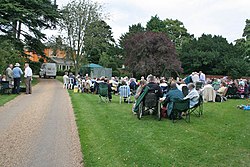Langar, Nottinghamshire
| Langar | |
| Nottinghamshire | |
|---|---|
 The lawns of Langar Hall | |
| Location | |
| Grid reference: | SK723346 |
| Location: | 52°54’14"N, -0°55’28"W |
| Data | |
| Population: | 980 (2011, with Barnstone) |
| Post town: | Nottingham |
| Postcode: | NG13 |
| Dialling code: | 01949 |
| Local Government | |
| Council: | Rushcliffe |
| Parliamentary constituency: |
Rushcliffe |
Langar is a village in the Vale of Belvoir, about four miles south of Bingham, in the south of Nottinghamshire, close by the Leicestershire border.
History
One of the first recorded landowners was Gerard de Rodes in the 12th century. The De Rodes family served as soldiers for King John, who visited Langar in 1215. The estate then passed to the Tibetots in the 13th century. Following the marriage of Margaret Tibetot to Roger Scrope, 2nd Baron Scrope of Bolton in 1373, the estate passed to the Scrope family.[1]
The last Lord Scrope who was associated with Langar was Emanuel Scrope, 1st Earl of Sunderland. Emanuel's estate was inherited by his illegitimate daughter, Annabella. In 1677, Annabella married the Gloucestershire politician John Howe, who held the manor in the time of the Nottinghamshire historian Thoroton, who wrote, Langar Hall and nearly the whole parish had lately become the estate of Mr Howe.
Every 1st of June, the village hall holds a celebration of a naval victory, 'the Glorious First of June', won by Richard Howe, 1st Earl Howe. Admiral Howe died in 1799 and is buried in Langar Church.
Parish church
The parish church, St Andrew's, is sometimes dubbed 'the Cathedral of the Vale' for its relative size. This may be in part due to its importance as a place of pilgrimage in Saxon times.
The former vicarage is a Grade II* listed Queen Anne house, on the junction of Church Lane and Barnstone Road.
Airfield

The village has lent its name to the Second World War airfield, RAF Langar, which is on the Nottinghamshire/Leicestershire boundary. The airfield was used for bombing operations over Germany by RAF Bomber Command. There is a war memorial there. 207 Sqn were based there. After the war it was by the Royal Canadian Air Force for many years. The airfield has served as the base for British Parachute Schools since 1977.
About the village
Lafarge Barnstone cement works lies south of Barnstone,, producing quick-setting cement by the addition of calcium sulphate.[2]
Naturescape Wildflower Farm is to the north of the airfield.

Adjacent to the church is Langar Hall, once the home of Earl Howe. The present building was built in 1837 and was later bought by Annie Bayley, wife of Thomas Bayley, the former Member of Parliament for Chesterfield. It is now a restaurant and hotel.
The Treasure of Robert Earnstock
It is known from evidence recovered from various places around the Vale of Belvoir that in the 17th century Robert Earnstock committed a series of robberies in the area. It was later discovered from letters that he was raising money to travel to his wife-to-be, who lived somewhere to the north of England. Earnstock kept the treasure hidden away until he had raised a small fortune, but as he neared his goal he was caught and hanged for his offences. His treasure was never found.
Unicorn's Head

The Unicorn's Head public house was built in 1717 and had its own brewhouse, which can still be identified by its unusual three-tier chimney to the south of the building. Its original name was The Feathers, taken from the plume in the Howe family crest. The current name was adopted after Admiral Howe's death, when the estate was bought in 1799 by John Wright, a Nottingham banker and a founder of the Butterley Company. He had a unicorn's head as his family crest. It remained a coaching inn in the 19th century and the original stables can still be seen at the back of the building.
Outside links
| ("Wikimedia Commons" has material about Langar, Nottinghamshire) |
References
- ↑ "Roger Scrope". thePeerage.com. http://www.thepeerage.com/p21158.htm#i211579.
- ↑ Special cements
